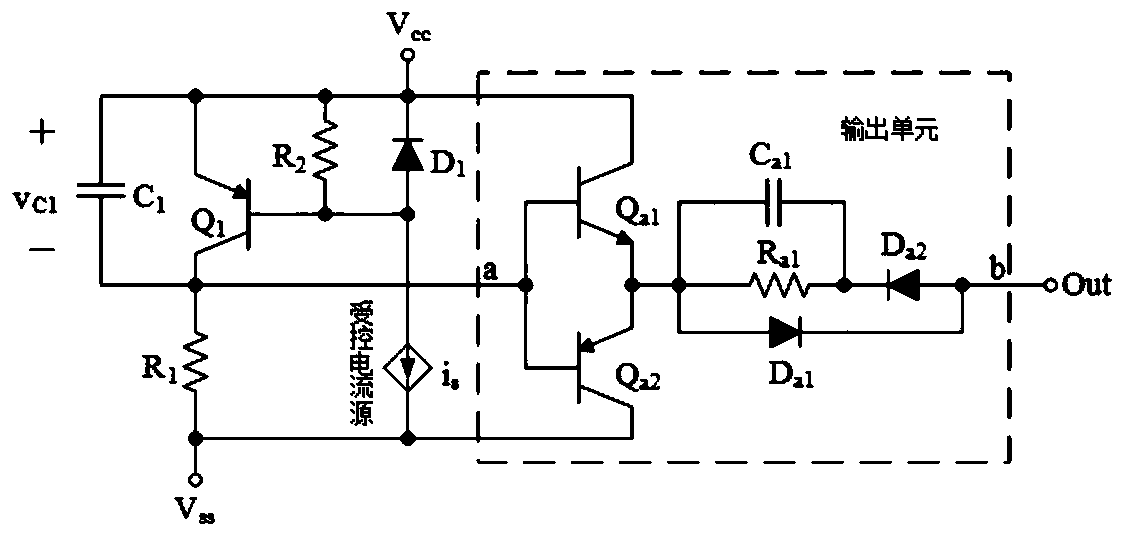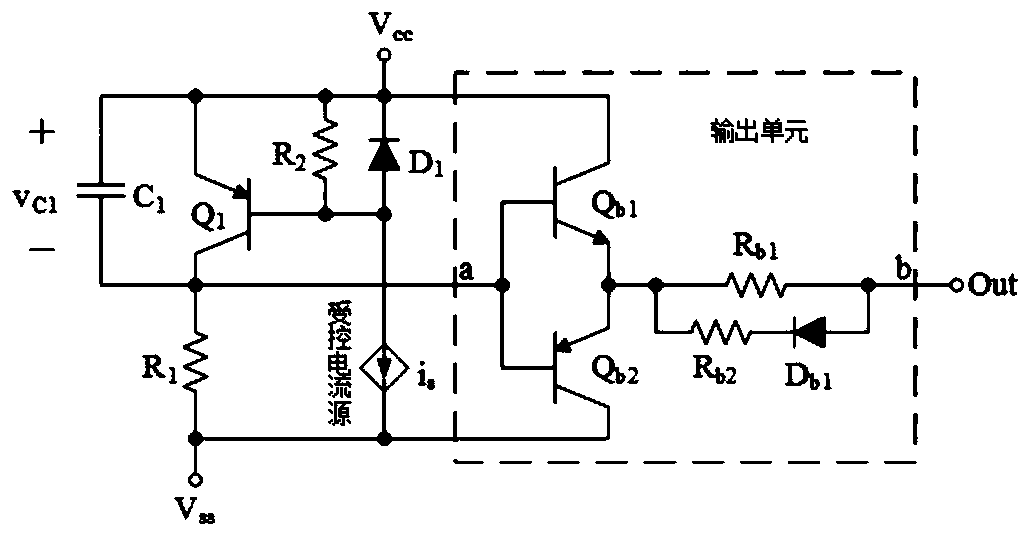PNP BJT combined capacitor charge-discharge controller with wide operating voltage range
A technology of working voltage range and combined capacitance, applied in control/regulation systems, instruments, electrical components, etc., can solve the problems of miniaturization and high efficiency of converters, occupying space, increasing losses, etc.
- Summary
- Abstract
- Description
- Claims
- Application Information
AI Technical Summary
Problems solved by technology
Method used
Image
Examples
Embodiment 1
[0044] refer to figure 1 and Figure 4 , a PNP BJT combined capacitor charging and discharging controller with a wide operating voltage range, including the port V cc , port V ss and port Out, also includes PNP type BJT tube Q 1 , Diode D 1 , capacitance C 1 , resistance R 1 , resistance R 2 , controlled current source and output unit, the output unit includes port a and port b, PNP type BJT tube Q 1 the emitter simultaneously with the resistor R 2 One end of the capacitor C 1 One end of the diode D 1 the cathode and the port V cc Connected, PNP type BJT tube Q 1 base simultaneously with resistor R 2 The other end of the diode D 1 The anode and the first port of the controlled current source are connected, and the PNP type BJT tube Q 1 collector simultaneously with capacitor C 1 The other end of the resistor R 1 One end of the output unit is connected to the port a of the output unit, the port b of the output unit is connected to the port Out, and the resistanc...
Embodiment 2
[0056] refer to figure 2 and Figure 4 , a PNP BJT combined capacitor charging and discharging controller with a wide operating voltage range, its output unit includes an NPN type BJT tube Q b1 , PNP type BJT tube Q b2 , resistance R b1 , resistance R b2 and diode D b1 , NPN type BJT tube Q b1 collector with port V cc Connected, NPN type BJT tube Q b1 The base of the output unit is simultaneously connected with the port a of the output unit and the PNP type BJT tube Q b2 The base is connected, PNP type BJT tube Q b2 collector with port V ss Connected, NPN type BJT tube Q b1 The emitter of the PNP type BJT tube Q b2 The emitter, resistor R b1 One end of the resistor R b2 Connected to one end of the resistor R b2 The other end of the diode D b1 connected to the cathode of the diode D b1 The anode of the resistor Rb1 is connected to the other end of the resistor Rb1 and port b at the same time.
[0057] The rest of embodiment 2 is the same as embodiment 1.
[0...
Embodiment 3
[0066] refer to image 3 and Figure 4 , a PNP BJT combined capacitor charging and discharging controller with a wide operating voltage range, its output unit includes a resistor R c1 and diode D c1 , resistor R c1One end of the diode D c1 The cathode is connected to port a, the resistor R c1 The other end of the diode D c1 The anode is connected to port b.
[0067] The rest of the embodiment 3 is the same as the embodiment 2, but the driving ability is weaker than that of the embodiment 2.
[0068] refer to Figure 11 , applying the controller to a step-down converter. In addition to the controller, the converter also includes an inductor L k1 , Diode D k5 , capacitance C k1 , Diode D k1 , Diode D k2 , PNP type BJT tube Q k1 , resistance R k1 , Diode D k3 , PNP type BJT tube Q k2 , resistance R k2 , Diode D k4 , inductance L k2 , capacitance C k2 , resistance R k3 , resistance R k4 and capacitance C k3 , the positive terminal of the DC power supply is ...
PUM
 Login to View More
Login to View More Abstract
Description
Claims
Application Information
 Login to View More
Login to View More - R&D
- Intellectual Property
- Life Sciences
- Materials
- Tech Scout
- Unparalleled Data Quality
- Higher Quality Content
- 60% Fewer Hallucinations
Browse by: Latest US Patents, China's latest patents, Technical Efficacy Thesaurus, Application Domain, Technology Topic, Popular Technical Reports.
© 2025 PatSnap. All rights reserved.Legal|Privacy policy|Modern Slavery Act Transparency Statement|Sitemap|About US| Contact US: help@patsnap.com



